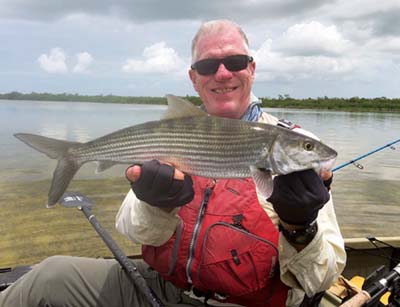
As a kayak fishing guide, I meet a wide variety of anglers, from novice to expert. Some of my clients just want an occasional day on the water, while others plan their vacations completely around fishing. One of my best anglers is John V., who averages 250 days on the water every year. John hails from Annapolis, Maryland, and is one of the best fishermen with a spinning rod that I’ve seen. He usually makes the trip to the Lower Florida Keys at least twice a year and will hire me for multiple days each time he visits.
He likes catching a variety of species, no matter the size. But there were a few fish on John’s bucket list for this trip, notably juvenile tarpon and goliath grouper. We had fished for tarpon on a previous trip, but our hookup ratio hadn’t been very good.

I suggested we make tarpon the focus of our trip, with an emphasis on improving our number of landed fish.
Consistent success with small tarpon does involve some simple, yet subtle techniques. The 2 things that are the trickiest for most anglers are knowing when to set the hook and how to set the hook. Regarding when, you want to wait until you’re sure the fish has eaten the bait. Many hair-triggered anglers will give a big yank as soon as they see or feel anything. Since tarpon aren’t “nibblers”, there’s no need to be too quick about the hookset. Sometimes the smaller fish will swipe at the lure and miss, even multiple times. But once you feel a strong pull from the fish, then set the hook. As to how, I like two short but very firm hook sets. The hard, bony mouth of a tarpon is a difficult place to plant a hook, but the dramatic over-the-shoulder stuff you see on TV isn’t recommended. Just a couple of short, very firm pops should do it. John patiently put all of these things into practice, and in two mornings of tarpon fishing, John jumped 12 fish and landed 7, which are solid numbers in the tarpon game!
Next on his bucket list was goliath grouper. I knew a few spots to find them but catching them is tricky due to the fact that they like to stay in the mangrove roots and generally will only come out briefly to eat before returning quickly back to the cover of the trees.

The rest of our time together was also productive with several species landed, including a fantastic sight-cast bonefish.
As always, if I can help you with your kayak fishing adventures in the Lower Florida Keys, call, text or email me anytime!
— Randy Morrow, Kayak Fishing Guide
LowerKeysKayakFishing.com | (305) 923-4643
